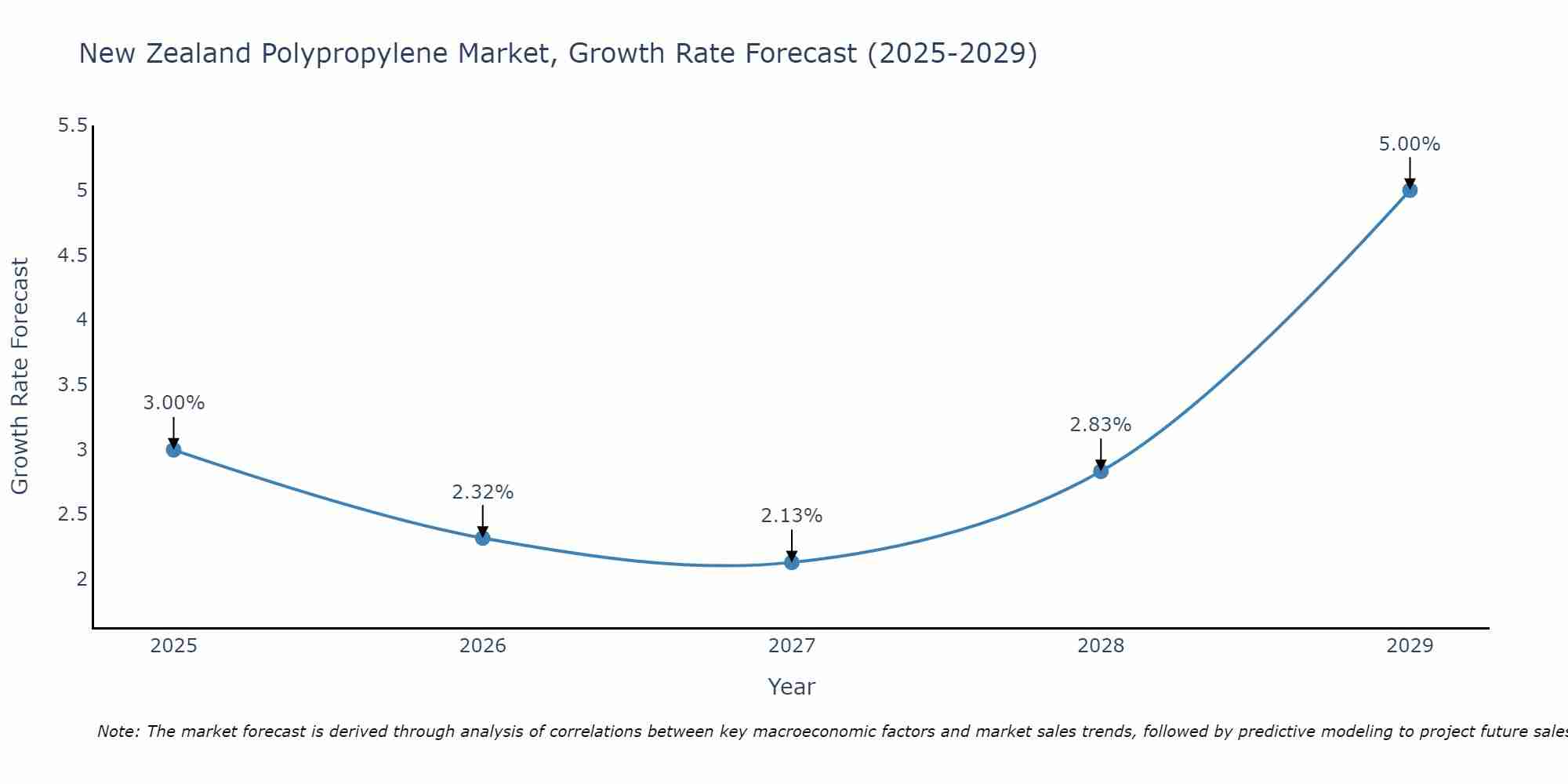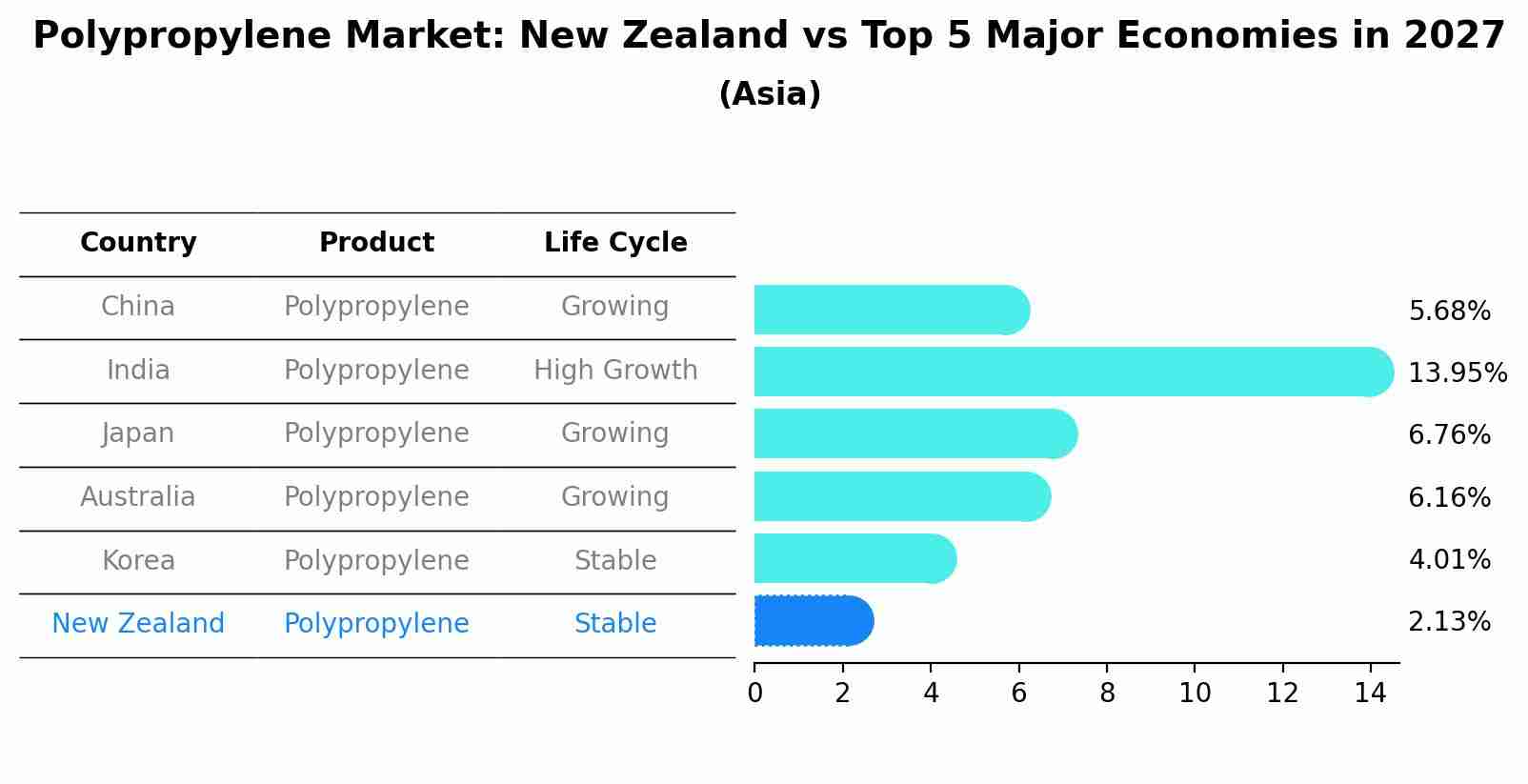New Zealand Polypropylene Market (2025-2031) | Revenue, Forecast, Analysis, Share, Industry, Trends, Segmentation, Outlook, Value, Growth, Companies & Size
| Product Code: ETC5054477 | Publication Date: Nov 2023 | Updated Date: Apr 2025 | Product Type: Market Research Report | |
| Publisher: 6Wresearch | Author: Sachin Kumar Rai | No. of Pages: 60 | No. of Figures: 30 | No. of Tables: 5 |
New Zealand Polypropylene Market Size Growth Rate
The New Zealand Polypropylene Market is projected to witness mixed growth rate patterns during 2025 to 2029. The growth rate starts at 3.00% in 2025 and reaches 5.00% by 2029.

Polypropylene Market: New Zealand vs Top 5 Major Economies in 2027 (Asia)
By 2027, the Polypropylene market in New Zealand is anticipated to reach a growth rate of 2.13%, as part of an increasingly competitive Asia region, where China remains at the forefront, supported by India, Japan, Australia and South Korea, driving innovations and market adoption across sectors.

New Zealand Polypropylene Market Overview
The Polypropylene Market in New Zealand encompasses the production and application of polypropylene in various sectors, including packaging, automotive, and consumer goods. Polypropylene is valued for its versatility, durability, and recyclability. The market growth is driven by increasing demand for sustainable and cost-effective materials in manufacturing and packaging applications.
Drivers of the market
The New Zealand polypropylene market is experiencing steady growth, driven by several factors. Polypropylene (PP) is one of the most widely used thermoplastics globally, owing to its versatile properties, including high chemical resistance, good fatigue resistance, and excellent processability. The increasing demand for PP in various end-use industries such as packaging, automotive, textiles, and healthcare has propelled market growth. Moreover, the growing trend towards lightweight and recyclable materials, coupled with the rising emphasis on sustainable packaging solutions, has further boosted the demand for PP in the region. Additionally, advancements in polymerization technologies and the development of innovative PP grades with enhanced properties have expanded the application scope of PP, driving market growth. However, fluctuating crude oil prices and environmental concerns associated with plastic usage may hinder market growth to some extent.
Challenges of the market
The polystyrene capacitors market in New Zealand is challenged by high production costs and the need for specialized manufacturing technologies. The market must navigate stringent environmental regulations, particularly regarding the sustainability and safety of polystyrene capacitors. Additionally, there is competition from alternative capacitor materials that offer similar properties at lower costs. Continuous innovation is required to improve the performance and environmental footprint of polystyrene capacitors.
Government Policy of the market
Polypropylene market in New Zealand is witnessing significant growth, supported by its wide-ranging applications in packaging, automotive, and consumer goods. Government initiatives promoting recycling and sustainable plastic usage are expected to shape the market`s future.
Key Highlights of the Report:
- New Zealand Polypropylene Market Outlook
- Market Size of New Zealand Polypropylene Market, 2024
- Forecast of New Zealand Polypropylene Market, 2031
- Historical Data and Forecast of New Zealand Polypropylene Revenues & Volume for the Period 2021-2031
- New Zealand Polypropylene Market Trend Evolution
- New Zealand Polypropylene Market Drivers and Challenges
- New Zealand Polypropylene Price Trends
- New Zealand Polypropylene Porter`s Five Forces
- New Zealand Polypropylene Industry Life Cycle
- Historical Data and Forecast of New Zealand Polypropylene Market Revenues & Volume By Type for the Period 2021-2031
- Historical Data and Forecast of New Zealand Polypropylene Market Revenues & Volume By Homopolymer for the Period 2021-2031
- Historical Data and Forecast of New Zealand Polypropylene Market Revenues & Volume By Copolymer for the Period 2021-2031
- Historical Data and Forecast of New Zealand Polypropylene Market Revenues & Volume By Application for the Period 2021-2031
- Historical Data and Forecast of New Zealand Polypropylene Market Revenues & Volume By Injection Molding for the Period 2021-2031
- Historical Data and Forecast of New Zealand Polypropylene Market Revenues & Volume By Fiber & Raffia for the Period 2021-2031
- Historical Data and Forecast of New Zealand Polypropylene Market Revenues & Volume By Film & Sheet for the Period 2021-2031
- Historical Data and Forecast of New Zealand Polypropylene Market Revenues & Volume By Blow Molding for the Period 2021-2031
- Historical Data and Forecast of New Zealand Polypropylene Market Revenues & Volume By End-use Industry for the Period 2021-2031
- Historical Data and Forecast of New Zealand Polypropylene Market Revenues & Volume By Packaging for the Period 2021-2031
- Historical Data and Forecast of New Zealand Polypropylene Market Revenues & Volume By Automotive for the Period 2021-2031
- Historical Data and Forecast of New Zealand Polypropylene Market Revenues & Volume By Building & Construction for the Period 2021-2031
- Historical Data and Forecast of New Zealand Polypropylene Market Revenues & Volume By Electrical & Electronics for the Period 2021-2031
- Historical Data and Forecast of New Zealand Polypropylene Market Revenues & Volume By Medical for the Period 2021-2031
- New Zealand Polypropylene Import Export Trade Statistics
- Market Opportunity Assessment By Type
- Market Opportunity Assessment By Application
- Market Opportunity Assessment By End-use Industry
- New Zealand Polypropylene Top Companies Market Share
- New Zealand Polypropylene Competitive Benchmarking By Technical and Operational Parameters
- New Zealand Polypropylene Company Profiles
- New Zealand Polypropylene Key Strategic Recommendations
Frequently Asked Questions About the Market Study (FAQs):
1 Executive Summary |
2 Introduction |
2.1 Key Highlights of the Report |
2.2 Report Description |
2.3 Market Scope & Segmentation |
2.4 Research Methodology |
2.5 Assumptions |
3 New Zealand Polypropylene Market Overview |
3.1 New Zealand Country Macro Economic Indicators |
3.2 New Zealand Polypropylene Market Revenues & Volume, 2021 & 2031F |
3.3 New Zealand Polypropylene Market - Industry Life Cycle |
3.4 New Zealand Polypropylene Market - Porter's Five Forces |
3.5 New Zealand Polypropylene Market Revenues & Volume Share, By Type, 2021 & 2031F |
3.6 New Zealand Polypropylene Market Revenues & Volume Share, By Application, 2021 & 2031F |
3.7 New Zealand Polypropylene Market Revenues & Volume Share, By End-use Industry, 2021 & 2031F |
4 New Zealand Polypropylene Market Dynamics |
4.1 Impact Analysis |
4.2 Market Drivers |
4.3 Market Restraints |
5 New Zealand Polypropylene Market Trends |
6 New Zealand Polypropylene Market Segmentations |
6.1 New Zealand Polypropylene Market, By Type |
6.1.1 Overview and Analysis |
6.1.2 New Zealand Polypropylene Market Revenues & Volume, By Homopolymer, 2021-2031F |
6.1.3 New Zealand Polypropylene Market Revenues & Volume, By Copolymer, 2021-2031F |
6.2 New Zealand Polypropylene Market, By Application |
6.2.1 Overview and Analysis |
6.2.2 New Zealand Polypropylene Market Revenues & Volume, By Injection Molding, 2021-2031F |
6.2.3 New Zealand Polypropylene Market Revenues & Volume, By Fiber & Raffia, 2021-2031F |
6.2.4 New Zealand Polypropylene Market Revenues & Volume, By Film & Sheet, 2021-2031F |
6.2.5 New Zealand Polypropylene Market Revenues & Volume, By Blow Molding, 2021-2031F |
6.3 New Zealand Polypropylene Market, By End-use Industry |
6.3.1 Overview and Analysis |
6.3.2 New Zealand Polypropylene Market Revenues & Volume, By Packaging, 2021-2031F |
6.3.3 New Zealand Polypropylene Market Revenues & Volume, By Automotive, 2021-2031F |
6.3.4 New Zealand Polypropylene Market Revenues & Volume, By Building & Construction, 2021-2031F |
6.3.5 New Zealand Polypropylene Market Revenues & Volume, By Electrical & Electronics, 2021-2031F |
6.3.6 New Zealand Polypropylene Market Revenues & Volume, By Medical, 2021-2031F |
7 New Zealand Polypropylene Market Import-Export Trade Statistics |
7.1 New Zealand Polypropylene Market Export to Major Countries |
7.2 New Zealand Polypropylene Market Imports from Major Countries |
8 New Zealand Polypropylene Market Key Performance Indicators |
9 New Zealand Polypropylene Market - Opportunity Assessment |
9.1 New Zealand Polypropylene Market Opportunity Assessment, By Type, 2021 & 2031F |
9.2 New Zealand Polypropylene Market Opportunity Assessment, By Application, 2021 & 2031F |
9.3 New Zealand Polypropylene Market Opportunity Assessment, By End-use Industry, 2021 & 2031F |
10 New Zealand Polypropylene Market - Competitive Landscape |
10.1 New Zealand Polypropylene Market Revenue Share, By Companies, 2024 |
10.2 New Zealand Polypropylene Market Competitive Benchmarking, By Operating and Technical Parameters |
11 Company Profiles |
12 Recommendations | 13 Disclaimer |
- Single User License$ 1,995
- Department License$ 2,400
- Site License$ 3,120
- Global License$ 3,795
Search
Related Reports
- Saudi Arabia Manlift Market (2025-2031) | Outlook, Size, Growth, Trends, Companies, Industry, Revenue, Value, Share, Forecast & Analysis
- Uganda Excavator, Crane, and Wheel Loaders Market (2025-2031) | Strategy, Consumer Insights, Analysis, Investment Trends, Opportunities, Growth, Size, Share, Industry, Revenue, Segments, Value, Segmentation, Supply, Forecast, Restraints, Outlook, Competition, Drivers, Trends, Demand, Pricing Analysis, Competitive, Strategic Insights, Companies, Challenges
- Rwanda Excavator, Crane, and Wheel Loaders Market (2025-2031) | Strategy, Consumer Insights, Analysis, Investment Trends, Opportunities, Growth, Size, Share, Industry, Revenue, Segments, Value, Segmentation, Supply, Forecast, Restraints, Outlook, Competition, Drivers, Trends, Demand, Pricing Analysis, Competitive, Strategic Insights, Companies, Challenges
- Kenya Excavator, Crane, and Wheel Loaders Market (2025-2031) | Strategy, Consumer Insights, Analysis, Investment Trends, Opportunities, Growth, Size, Share, Industry, Revenue, Segments, Value, Segmentation, Supply, Forecast, Restraints, Outlook, Competition, Drivers, Trends, Demand, Pricing Analysis, Competitive, Strategic Insights, Companies, Challenges
- Angola Excavator, Crane, and Wheel Loaders Market (2025-2031) | Strategy, Consumer Insights, Analysis, Investment Trends, Opportunities, Growth, Size, Share, Industry, Revenue, Segments, Value, Segmentation, Supply, Forecast, Restraints, Outlook, Competition, Drivers, Trends, Demand, Pricing Analysis, Competitive, Strategic Insights, Companies, Challenges
- Israel Intelligent Transport System Market (2025-2031) | Strategy, Consumer Insights, Analysis, Investment Trends, Opportunities, Growth, Size, Share, Industry, Revenue, Segments, Value, Segmentation, Supply, Forecast, Restraints, Outlook, Competition, Drivers, Trends, Demand, Pricing Analysis, Competitive, Strategic Insights, Companies, Challenges
- Uganda Precast and Aggregate Market (2025-2031) | Strategy, Consumer Insights, Analysis, Investment Trends, Opportunities, Growth, Size, Share, Industry, Revenue, Segments, Value, Segmentation, Supply, Forecast, Restraints, Outlook, Competition, Drivers, Trends, Demand, Pricing Analysis, Competitive, Strategic Insights, Companies, Challenges
- Australia IT Asset Disposal Market (2025-2031) | Strategy, Consumer Insights, Analysis, Investment Trends, Opportunities, Growth, Size, Share, Industry, Revenue, Segments, Value, Segmentation, Supply, Forecast, Restraints, Outlook, Competition, Drivers, Trends, Demand, Pricing Analysis, Competitive, Strategic Insights, Companies, Challenges
- UAE Building Thermal Insulation Market Outlook (2025-2031) | Revenue, Companies, Share, Trends, Growth, Size, Forecast, Industry, Analysis & Value
- Portugal Electronic Document Management Market (2025-2031) | Strategy, Consumer Insights, Analysis, Investment Trends, Opportunities, Growth, Size, Share, Industry, Revenue, Segments, Value, Segmentation, Supply, Forecast, Restraints, Outlook, Competition, Drivers, Trends, Demand, Pricing Analysis, Competitive, Strategic Insights, Companies, Challenges
Industry Events and Analyst Meet
Our Clients
Whitepaper
- Middle East & Africa Commercial Security Market Click here to view more.
- Middle East & Africa Fire Safety Systems & Equipment Market Click here to view more.
- GCC Drone Market Click here to view more.
- Middle East Lighting Fixture Market Click here to view more.
- GCC Physical & Perimeter Security Market Click here to view more.
6WResearch In News
- Doha a strategic location for EV manufacturing hub: IPA Qatar
- Demand for luxury TVs surging in the GCC, says Samsung
- Empowering Growth: The Thriving Journey of Bangladesh’s Cable Industry
- Demand for luxury TVs surging in the GCC, says Samsung
- Video call with a traditional healer? Once unthinkable, it’s now common in South Africa
- Intelligent Buildings To Smooth GCC’s Path To Net Zero













